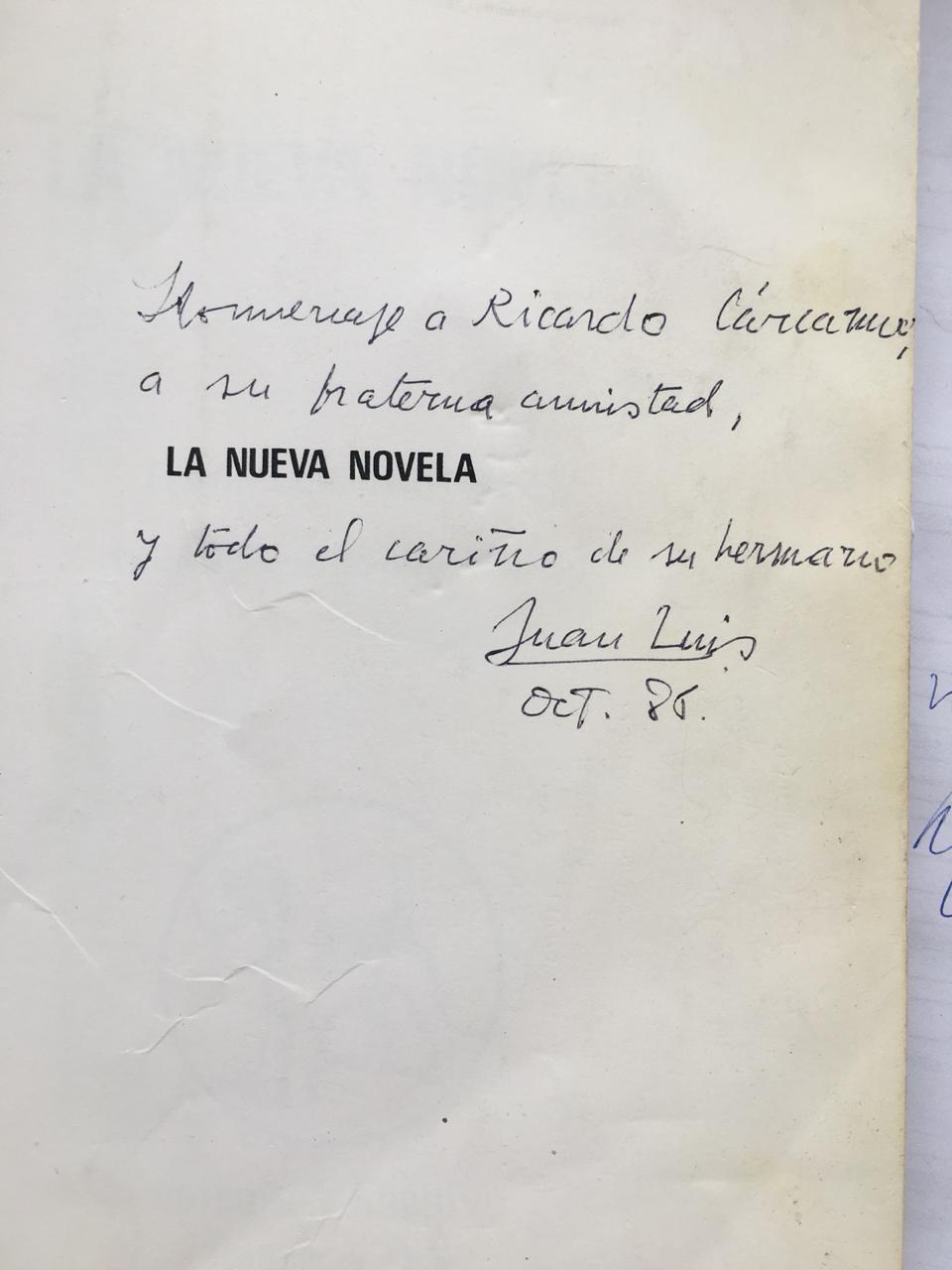
However, on July 7, 2017—on the 40th anniversary of the publication of La nueva novela [The new novel], and on what would have been Martínez’s 75th birthday—the Martínez family and patron Pedro Montes released a facsimile edition of his masterpiece La nueva novela, which included hand-written comments ostensibly made by the author. This edition of 300 copies sold for 150.000 Chilean pesos (approximately $250) and contains numerous annotations in Martínez own hand—or so it seemed. In the summer of 2018, however, a controversy emerged regarding the authenticity of these hand-written comments. The author of these annotations was allegedly not Juan Luis Martínez, but rather a former literature student named Ricardo Cárcamo, who maintains that he is the true author of the hand-written notes reproduced in the 2017 edition of La nueva novela. This interview took place on September 22, 2018.
Scott Weintraub
University of New Hampshire
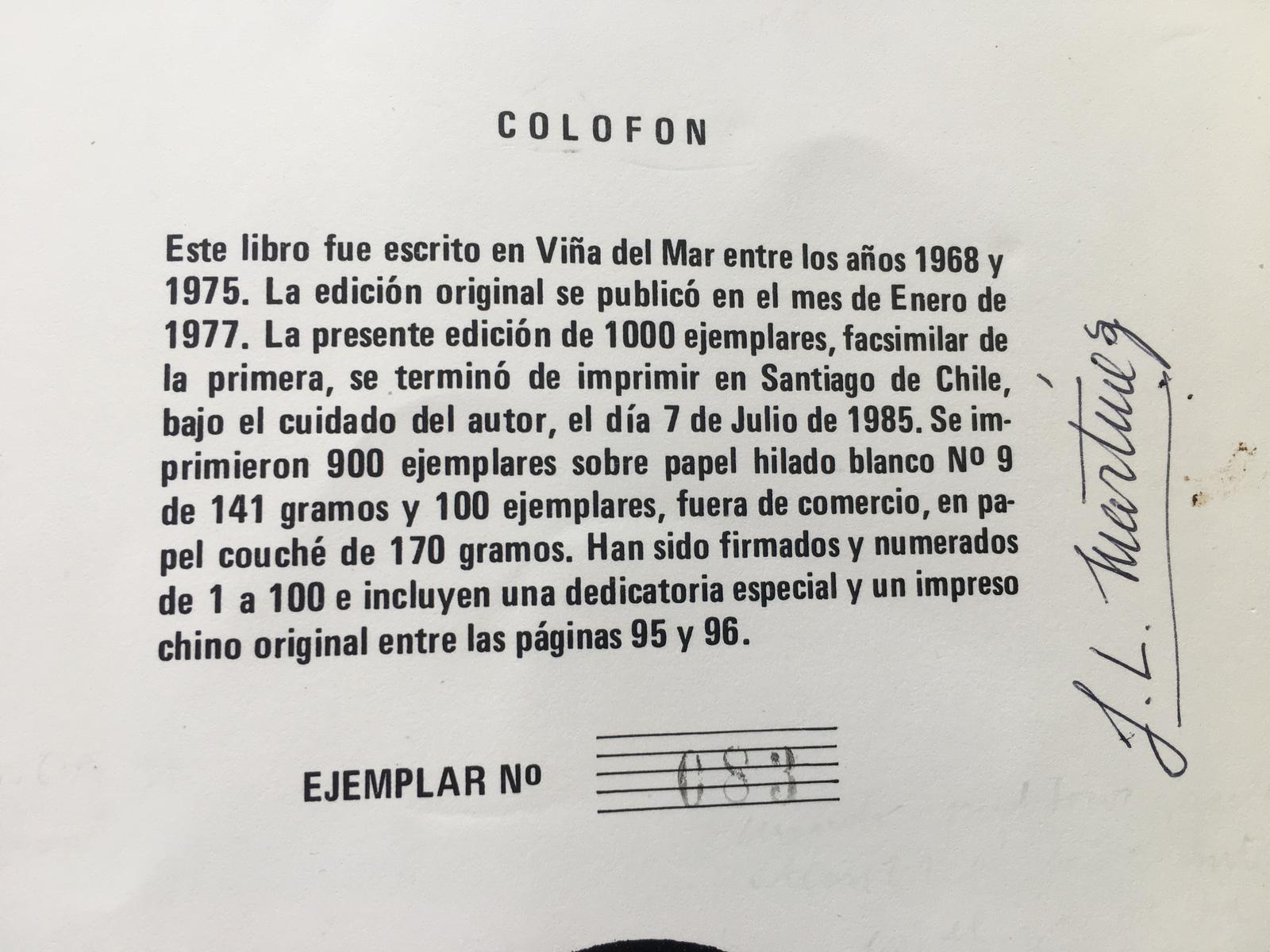
Scott Weintraub: How and when did you become interested in Juan Luis Martínez’s poetry?
Ricardo Cárcamo: I lived on Valparaíso Street in Viña [del Mar] and I studied literature at the Catholic University of Valparaíso. Across from my apartment there was a bookstore called Nobel Books, which isn’t there anymore; the owner was my friend. He would save the new things he received for me and show them to me, and that time it was a box containing a book and a plastic bag filled with earth. It was Chilean Poetry, it must have been ‘80 or ’81, the strangest thing but also extraordinary. It was peerless in the literature I had had access to up until that point, it was unthinkable that it was also studied in university classrooms at the time. To me it was like a 10.0 earthquake in my brain, like the destruction of linear literature when I read Hopscotch [by Julio Cortázar]. Oneiric and concrete. It was my first encounter with Juan Luis Martínez.
SW: How did you meet Juan Luis Martínez? How did you obtain your first copy of The New Novel?
RC: First I asked my friend Patricio González—who at that time worked in the bookstore Feria Chilena del Libro in Viña del Mar—how to find Juan Luis. Patricio told me that Juan Luis always went there, and even pointed out the chair where he used to sit. “You can meet him here,” he told me, and with a brief physical description it was easy for me to find him. So when he showed up, we [Martínez and I] started talking, not without a great deal of nervousness on my part. I had references from the Café Cinema group, the center of local poetry in the ‘60s and ‘70s. That was the main topic of our first conversation. Juan Luis suddenly said to me, “Please don’t address me formally because it makes me feel old.” We laughed and I feel like that laughter was the beginning of our friendship. He then invited me to his home, where I got to know his more intimate environment, Elianita, and his young daughters Alita and María Luisa. Two weeks later he lent me a copy of The New Novel. Juan Luis was like that: generous and with all the time in the world to listen and to respond. Many of these responses stuck with you for weeks. I always felt that I was with an extraordinary being in every sense of the word, a kind of “illuminated one,” a rebellious monk with a simplicity, warmth, and knowledge that were truly unique. I think these epithets have only grown with time.
SW: What do you think of The New Novel?
RC: I should say in proper Chilean Spanish that it is “pelacables” [“crazy”]: Chilean Poetry is superlative, but The New Novel is unnamable. I think it is a unique work with no point of comparison in literature. I have a lasting memory of that time and I see Juan Luis walking for hours with Juan Luis Moraga, an architect in Viña, and with Mauricio Barrientos, a poet who died very young. He is the author of the book The Inverted Man. I see Juan Luis going to the Altazor Bookstore, chatting in a café with Sergio Madrid or talking to Arturo Ariztia in the street, oh my, so many memories…
SW: How did the idea of annotating The New Novel come about? Whose copy was the annotated one? What was the process of annotating The New Novel like? How did Juan Luis Martínez react? Did you work together to write the notes?
RC: So I lived in an old, large apartment, which I shared with two other students. I had three rooms to myself. One was my bedroom, one had my desk and library, and the third one was a workshop for painters. Juan Luis lent me a copy that I photocopied and upon which I began working, staging one of the rooms of the apartment as a kind of art exposition. I put all of The New Novel up on the four walls of the room. This must have been towards the end of 1984. I sat down and started to look for relationships. Juan Luis gave me some tips: “In The New Novel you must always relate a given page with the one before it and the one after it, going from one page to the next.” I quickly began to understand it after six months of reading and taking notes daily. In fact, I still have the copy of the 1985 edition that Juan Luis gave me, with some hand-written annotations that are not in the edition that was published in 2017.
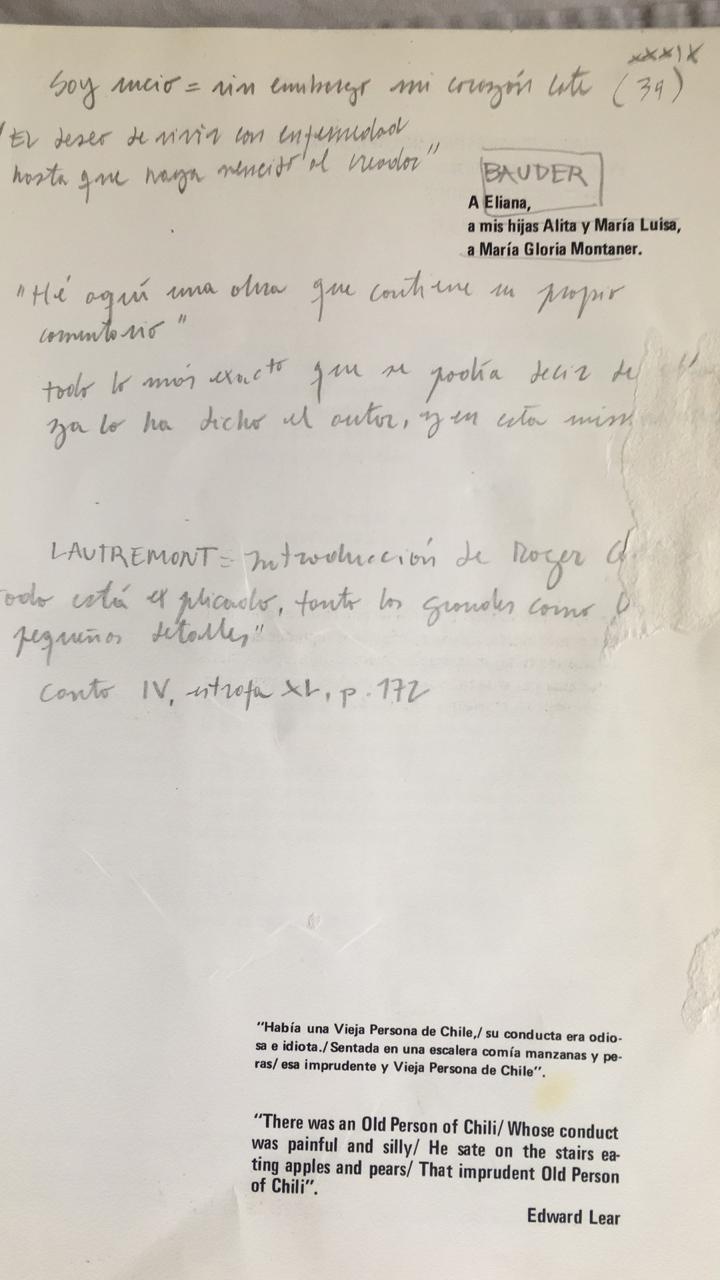
SW: How did you find out about the publication of the annotated New Novel in July 2017? How did you react?
RC: So I work in Santiago and I live in Viña; between March and September I commute back and forth daily. Early one morning I ran into Felipe Acuña, a writer from Viña del Mar, who told me that on July 7th, 2017 they were going hold a book launch for an edition of Juan Luis Martínez’s The New Novel, which had annotations by Martínez himself. Acuña, who knew of my closeness to Martínez’s work, invited me to the presentation. I went to the launch with Acuña and saw Eliana Rodríguez, Martínez’s widow. She didn’t see me, nor did Patricio González, who was also there in his capacity as presenter and as the coordinator of the book launch. After presentations by Ismael Gavilán and Jorge Polanco there was a reception. I was talking to Acuña about whether this was the third or fourth edition [of The New Novel]. However, I almost had a heart attack when I saw this new edition, the fourth one, which had been presented just a few minutes earlier. I had written the annotations in the 2017 edition of The New Novel years ago! I left immediately. To be honest, upon returning home I was doubting my own writing. When my wife came home that night I explained the situation to her. I said to her: “How wonderful that they confused Ricardo Cárcamo’s notes with those of Juan Luis Martínez!” [Laughs].
SW: And what happened next?
RC: The next day I talked to Patricio González, he has been my friend since 1979. I told him the story. I knew that I could talk to him in confidence and without any duplicity on his part. Patricio told me, and repeated, that when he saw the 2017, annotated edition of The New Novel he immediately knew that it was my handwriting and not Juan Luis’. He has a sharp designer’s eye since he works as an editor. He was emphatic in pointing out that he did not see the book until it was printed and ready to be sent to Gavilán and Polanco so that they could prepare their presentations. Patricio suggested that we meet with Eliana to clarify the situation. On July 17 or 18, 2017, I met with Eliana Rodríguez and Patricio González at the Anayak cafeteria on Fifth Street in Viña; however, on July 13, before talking to Eliana, I went to Santiago to Gallery D21—which is owned by Pedro Montes—to buy a copy of the book.

SW: And what was decided at that meeting?
RC: After this conversation [with Eliana], with Patricio González present, they asked me to decide on the course of action to be taken. I vehemently said: “return the money to people who bought the book and destroy all of the copies.” Eliana then replied: “what a shame, Pedro has been so good to us, it would be terrible if he found out about this.” So we then made what might be called a “pact of silence” so that Pedro Montes wouldn’t find out. Which was obviously a blunder on our part. After this meeting there was a long pause. For business reasons I was away from Viña between September 10 and July 13, 2018. During that time I had no contact with Eliana Rodríguez. However, several friends had contacted me to ask me what was happening with this situation and I had trouble sleeping. So on Thursday, August 2, 2018, I again met with Patricio González and Eliana Rodríguez in the cafeteria of the Palacio Rioja in Viña del Mar. In the name of Juan Luis Martínez, in honor of his memory, and because this was a question of ethics, I demanded three things: first, that they tell Pedro Montes the truth; second, that Jorge Polanco, Ismael Gavilán, and Diego Zúñiga (who had written an article about the annotated edition for Revista Qué pasa) be made aware of the situation; and third, that this information appear in a newspaper with national circulation. I gave them until August 31, 2018.
SW: And what happened?
RC: Patricio González told me that on Thursday, August 9, 2018, he went to Santiago with Eliana to tell Pedro Montes what had happened. I met with [Montes] later. Now then, it is important that I clarify that I contacted him because Eliana Martínez emphatically asked me to do it since Pedro Montes, who was the editor of this edition, should have contacted me to give me an explanation about this case. When I talked to him, I told him, “you are an attorney, you know what this could mean legally, and you are also the editor of a tremendously important body of work, where these kinds of things need to be checked five times over.” The temporary solution was for him to put me in contact with [Daniel] Rosas of the newspaper La Segunda; he would interview me. I was clear that the interview needed to take place after a public clarification and private apologies to Zúñiga, Gavilán and Polanco, in the name of respect for JLM and for them. I insist that I don’t need them to mention me, they (Eliana Martínez and Pedro Montes) just need to confirm the error and nothing more. I have the honor and pride to say that Montes and the Foundation financed hundreds of copies of Ricardo Cárcamo’s notes [laughs].
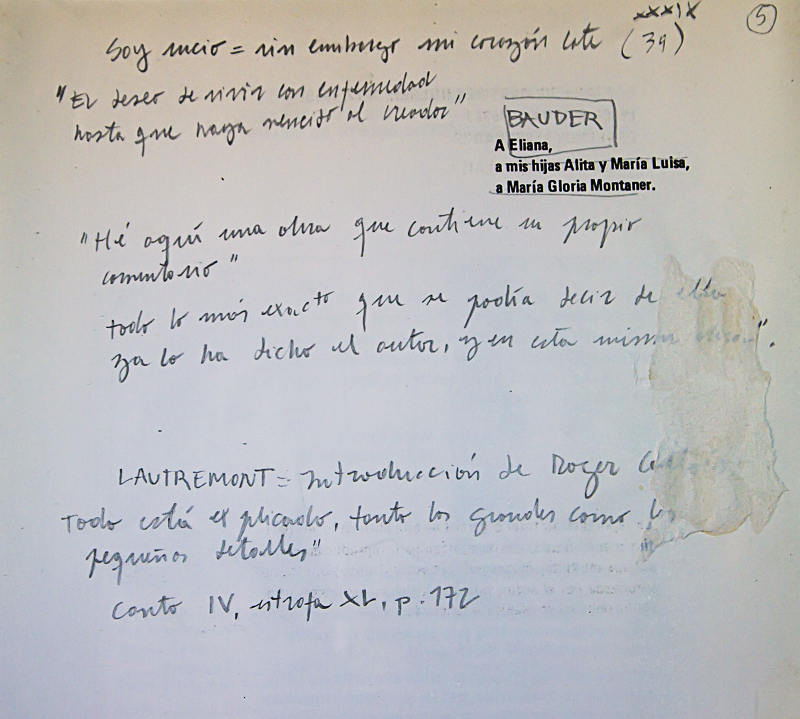
SW: At any time did you have the impression that Eliana Rodríguez knew that the annotations were not Juan Luis’?
RC: Unfortunately yes. They were married for 21 years, how could you not know your husband’s handwriting?
SW: And Pedro Montes? Do you think he knew?
RC: I don’t think so. But I insist, it’s hard for me to believe that as an editor and also as an attorney he didn’t pay sufficient attention to detail to verify the authenticity and source of the hand-written notes that he was publishing.
SW: Why are you making this public complaint now?
RC: Because I don’t want to be complicit in this deception and I want a definitive resolution. It is an ethical issue, a question of transparency, one that literally has not let me sleep in peace. I also believe that apologies should be made to Zúñiga, Gavilán, and Polanco.

SW: How can you prove that the notes in the annotated The New Novel published in July 2017 are yours?
RC: Because they are in my handwriting and correspond to a project in which I was immersed for an entire semester, surrounded by a group of close friends who can attest to this. Should the case require it, I could provide a handwriting sample as legal proof. Also, I still have the cover and an additional page with annotations by me that are the same as the ones that appear in this fourth edition.
SW: Who has the copy of The New Novel that Juan Luis Martínez gave you, in which you transcribed your notes?
RC: Juan Luis Martínez gave me two copies of The New Novel. One, which I still have, and which he gave to me as a gift, is from 1985, is signed, and has some notes. The other copy he gave me was blank and in it I transcribed the content of the photocopies that I had made of The New Novel. Here, I transcribed all of the notes that were published in the 2017 edition.
SW: So you wrote notes in two copies of The New Novel?
RC: Precisely. As I stated previously, Juan Luis Martínez lent me a copy of The New Novel, which I photocopied in its entirety. It would have been the 1977 edition. I returned that copy to him and kept the photocopies, which I used to begin studying the text. This must have been in mid-1984. In 1985 Juan Luis Martínez gave me a copy of the second edition; it was number 083 and he dedicated it to me in an act of friendship: “In honor of Ricardo Cárcamo and his close friendship; warmly, from your brother: Juan Luis. Oct. 86”. On my own initiative I began to study and analyze The New Novel, inscribing my conclusions or ideas on the photocopies and in the copy that Juan Luis gave me. So the photocopies have my first annotations that I would complement with others written later on the photocopies themselves. And at the same time I wrote exactly the same annotations on the copy that Juan Luis Martínez had given me.
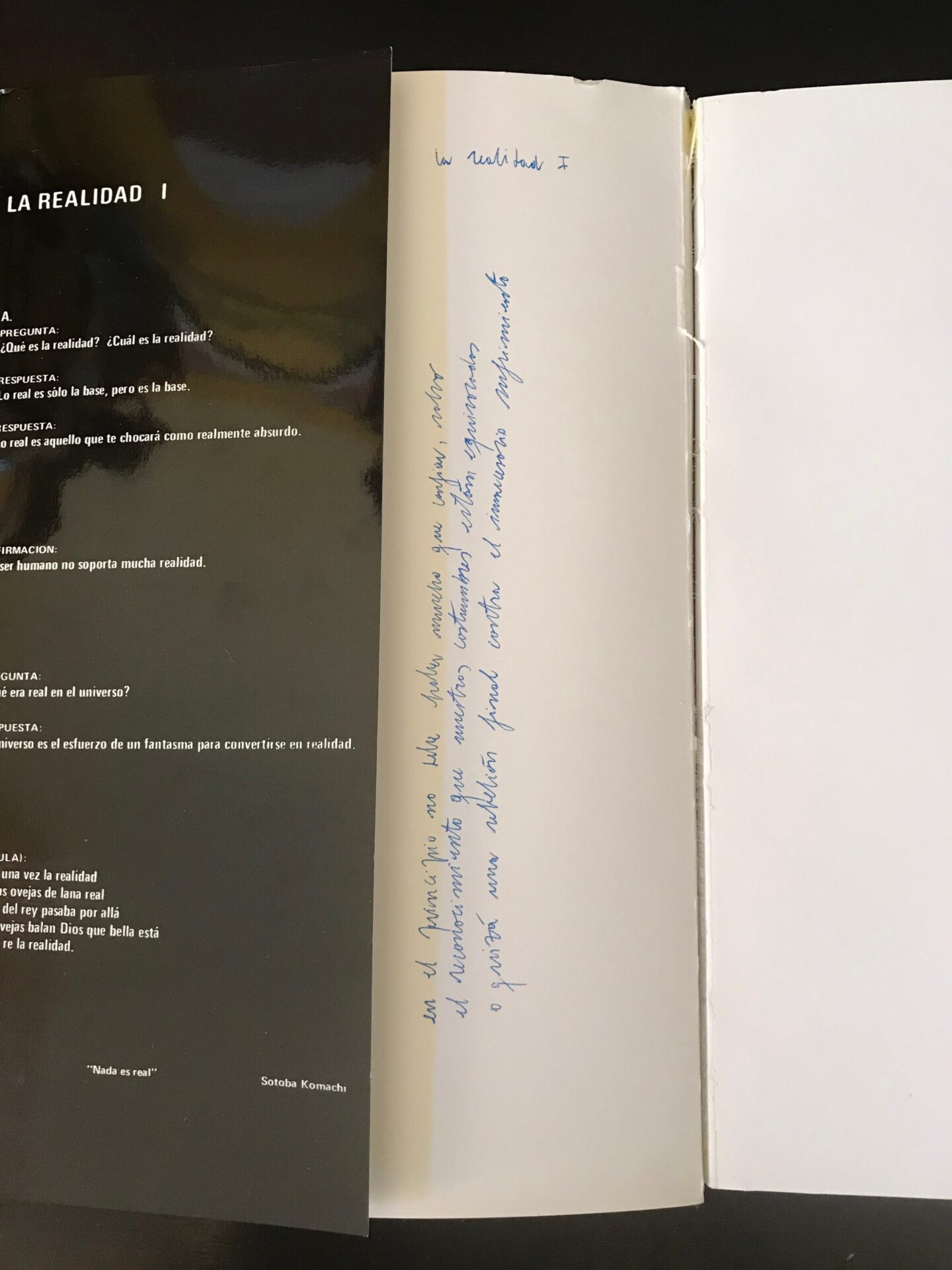
SW: Juan Luis Martínez knew that you were doing this project?
RC: Of course, he went to my apartment and saw the room with the annotated photocopies.
SW: How did your annotations make their way into the copy upon which the 2017 edition was based?
RC: When Juan Luis gave me the copy of The New Novel he asked me to transcribe all of my notes about The New Novel into a blank copy. It was a copy of the 1985 edition.
SW: What did you do when you finished transcribing those notes?
RC: I gave them to Juan Luis and he kept that copy, it is the one that the family and Pedro Montes, the editor of the 2017 edition, have today. When I talked to Pedro a second time, he showed me that copy.
SW: But did you have the other copy that also contained notes?
RC: I kept the copy that was number 083, in which there appear the annotations that I did on the two flaps and on the dedication page. In other words, the copy that the family possesses has all of the annotations from the photocopies in addition to these three annotations that come from my original copy of the book, which was given to me by Juan Luis Martínez. These annotations were reproduced in the 2017 edition, but they are not exactly the same, since they omitted various annotations.
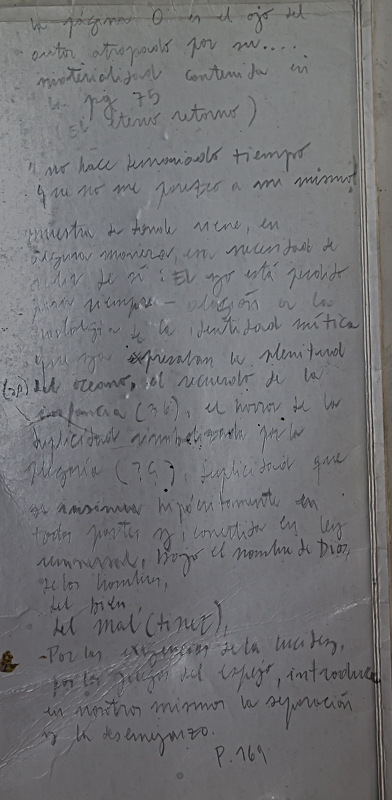
SW: Which annotations?
RC: An omitted annotation is on the first flap; it reads: “The real eternal truth in the universe is that man cannot possess.” This annotation has a graphic with an arrow pointing to the phrase “Reality I.” The second annotation is on the fifth page of The New Novel, which has the dedication. They left out several notes there. One of them says “I am dirty yet my heart still beats (39).” Above the number 39 there appears the same number written with Roman numerals. There is another comment in quotation marks: “The desire to live with illness until the creator is defeated.” Next, above Eliana’s name it says “Bauder.” There are more comments on this page, which don’t appear in the 2017 edition [which was based on the 2016 edition]. Here it says: “LAUTREAMONT just as Roger Callois’ Introduction all is explained, the large and small details.” And this observation refers to Canto IV, Stanza XL, page 172.
SW: You say that on this page Eliana’s name appears in your edition, but in the one I have her name is not there, but Roger Callois’ is. How do you explain this discrepancy?
RC: The first 100 copies have another dedication, which says: “To Eliana / To my daughters Alita and María Luisa / To María Gloria Montaner.” And beginning with copy 101, I suppose, the dedication to Roger Callois appears, as we all know.
SW: After all of this, how do you see the situation now? In your opinion, what should Montes and the Martínez family do?
RC: This is indeed a blemish on [Montes’] credibility as an editor. That is a problem that I’m not responsible for. Pedro Montes hasn’t been up to the task and has not taken responsibility for his error. In his role as the editor I had to go see him in Santiago on two separate occasions in order to clear up this situation, one that in my opinion is not minor. Even though he knows that I have serious mobility problems, which resulted from a sciatic-lumbar operation. Now I don’t think it is a question of returning money, of destroying copies. Two months have gone by…What is lacking is a public clarification and also a private one. I insist that I’m not looking for any kind of cheap fame and that all of this has a direct relationship with Juan Luis Martínez’s work, nothing more.

SW: Do you think that using La Segunda is a way to bury the news?
RC: Yes. Not giving any importance to something relevant. If they want to continue selling copies of the edition there should be a colophon: something printed about an involuntary errata/error on the Editor/Editors’ part.
SW: So, in the end, the annotations in the 2017 edition of The New Novel are yours.
RC: Absolutely, the annotations in the 2017 edition of The New Novel are mine.
Translated by Scott Weintraub


